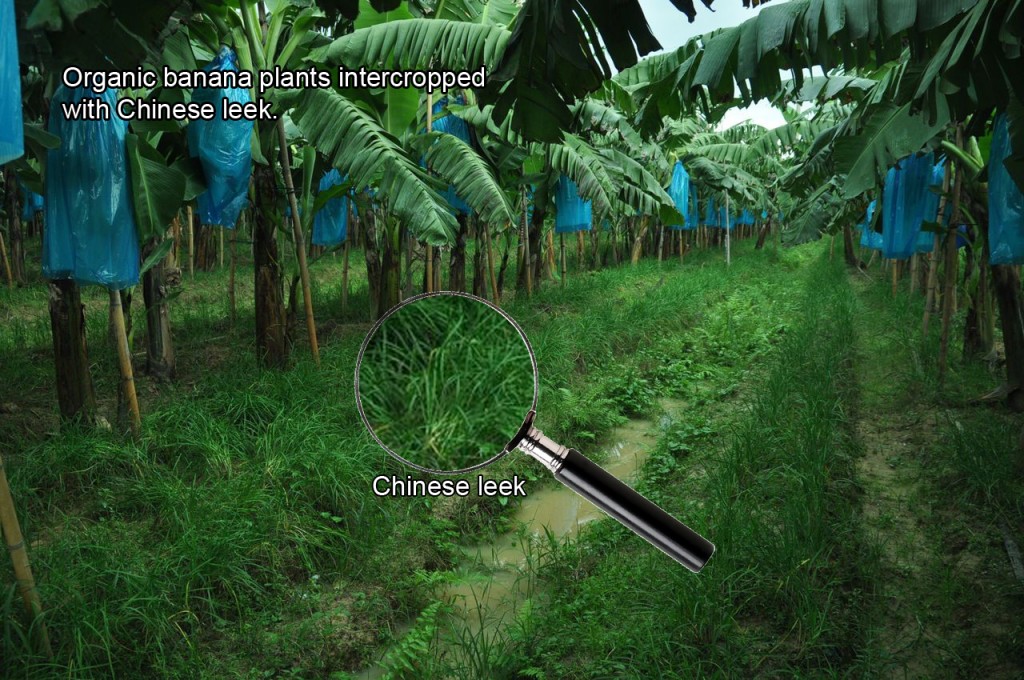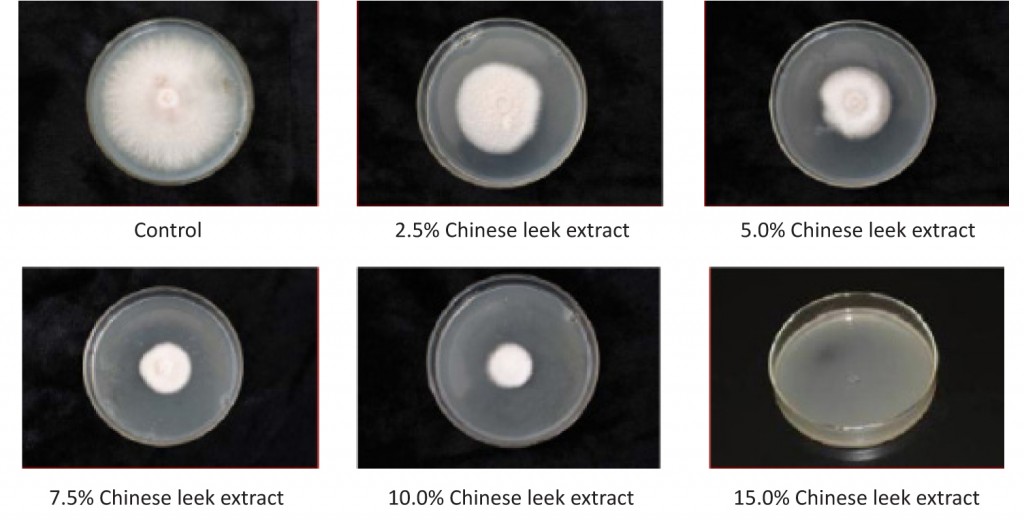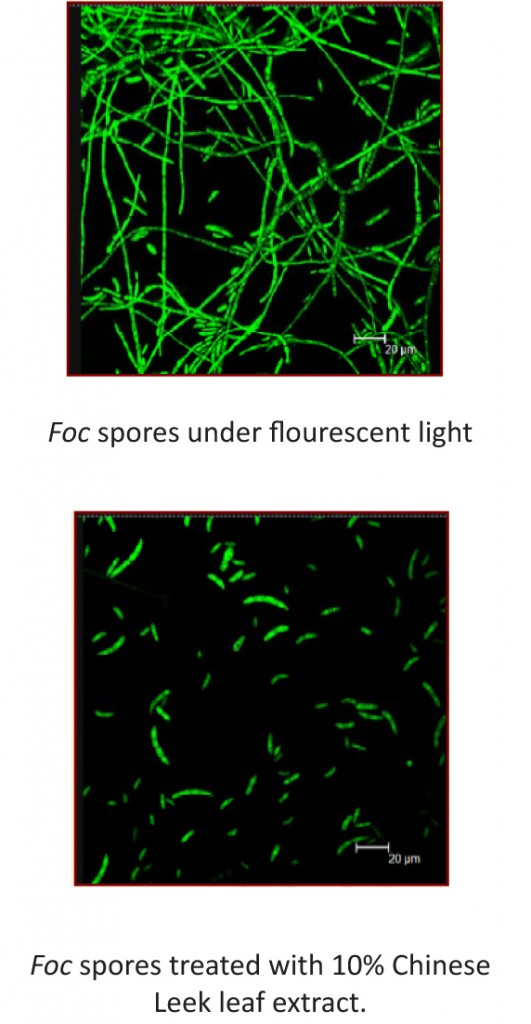Fusarium wilt, caused by fungus Fusarium oxysporum f. sp. cubense (or simply Foc), is a disease that threatens banana production worldwide. From the 1950s to 1960s, Foc race 1 devastated the Central American and Caribbean banana plantations that grew the ‘Gros Michel’ variety. This made the farmers switch to the Cavendish variety. Since then, Foc has developed more resistant strains. Foc race 4 is a virulent strain that affects the Cavendish, decreasing the banana production area in Taiwan from 50,000 ha to 5,000 ha in the 1970s.
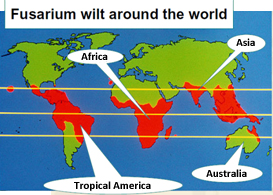 Foc has virtually spread to every continent in the world. In China, the disease destroyed the banana industry in the Chinese mainland, including Guangdong, Hainan, Guangxi, Fujian and Yunnan. In the delta of the Pearl River, the presence of the fungus ranges between 10 to 40 percent of the land area, with individual plantations reaching up to 90%. Due to the disease, many banana plantations were abandoned.
Foc has virtually spread to every continent in the world. In China, the disease destroyed the banana industry in the Chinese mainland, including Guangdong, Hainan, Guangxi, Fujian and Yunnan. In the delta of the Pearl River, the presence of the fungus ranges between 10 to 40 percent of the land area, with individual plantations reaching up to 90%. Due to the disease, many banana plantations were abandoned.
The pathogen infects banana roots and stems by colonizing the xylem vessels and preventing the flow of nutrients. This causes a reddish-brown discoloration of the rhizome and stems. The leaves of the plants eventually become bright yellow before they wilt and shed. The banana plants often die before they can produce fruit, reducing yield. Since Foc can survive in soil for decades, plants can only be grown in soil free of the pathogen.
In 1997, all banana trees in a Chinese farm showed visible symptoms of Foc infection except for a small group of plants. The healthy banana trees were planted next to a patch of Chinese leek (Allium tuberosum) that has been grown for two or three years. After that, farmers planted bananas in Chinese leek fields and met success. The Chinese leek-banana rotation system was gradually accepted by more and more farmers.
Field studies
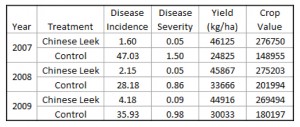
Field studies were conducted in the Panyu area of Guangdong, China. The area was chosen because of its severe infection of Foc. Panyu has a southern subtropical marine monsoon climate and an annual precipitation is about 1900mm, and a mean annual temperature of 21.6 C.
The three-year study yielded positive results. The incidence of the disease is found to be nearly 30 times less in bananas trees planted with Chinese leeks on the first year, 13 times less on the second year, and 8.6 times less on the third year. Likewise, the disease is 30 times less severe in plants with the Chinese leeks on the first year, 17 times on the second year, and about 11 times on the third year. The yield produced was about twice more in the bananas planted with Chinese leeks on the first year, 36% more on the second year, and about 50% more on the third year.
Greenhouse study
Two sets of greenhouse experiments were done to test the effect of Foc spores on potted banana seedlings. For the first experiment, 20,000 spores were inoculated per peat and the plants were observed for 60 days. For the Baxi variety, disease incidence reduced by 70% and severity index by 86.9% for seedlings treated with Chinese leek leaves. For the Guangfen No. 1 variety, disease incidence reduced by 76.7% and disease severity index reduced by 93.4%.
In the second greenhouse experiment, 5,000 Foc spores were inoculated per peat and the plants were observed for 150 days. For the Baxi variety, disease incidence reduced by 58.6% and disease severity index reduced by 61.82% for seedlings treated with Chinese leek leaves. For the Guangfen No. 1 variety, disease incidence reduced by 79.7% and disease severity index reduced by 80.67%.
Laboratory Anti-fungal Experiment
The growth of Foc mycelium, or the vegetative part of the fungus, was observed on petri dishes. A solution containing different amounts of Chinese leek extract was applied to each dish and was allowed to incubate for 7 days. The test was replicated 6 times and the Foc was completely suppressed with the 15.0% Chinese leek solution.
When exposed and examined with a fluorescence microscope, different parts of the fungus showed signs of inflammation, inflation, abnormalities, and malformations.
Under the electron microscope, Foc cell structure showed signs of plasmolysis, flaking of cell wall, shrinking of cytoplasm, and decomposition of cell structure.
Proliferation of Foc spores were also observed under fluorescent and visible light. At 10% extract of the Chinese leek leaves, Foc spores were nearly completely suppressed.
– Based on a presentation by Chun-yu Li* and Gan-jun Yi* in the workshop on Integrated Approaches in Banana Disease Management in Serdang, Malaysia, 22 Mar 2011
*Banana Research Center, Fruit Research Institute, Guangdong Academy of Agriculture Science

